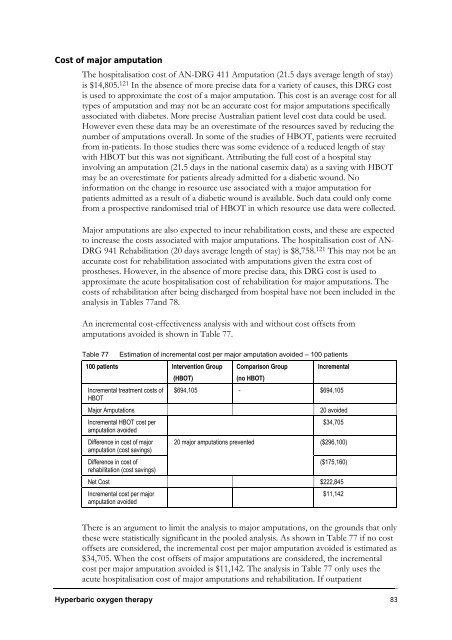Hyperbaric Oxygen Therapy - Hyperbaric Chamber Information ...
Hyperbaric Oxygen Therapy - Hyperbaric Chamber Information ...
Hyperbaric Oxygen Therapy - Hyperbaric Chamber Information ...
Create successful ePaper yourself
Turn your PDF publications into a flip-book with our unique Google optimized e-Paper software.
Cost of major amputation<br />
The hospitalisation cost of AN-DRG 411 Amputation (21.5 days average length of stay)<br />
is $14,805. 121 In the absence of more precise data for a variety of causes, this DRG cost<br />
is used to approximate the cost of a major amputation. This cost is an average cost for all<br />
types of amputation and may not be an accurate cost for major amputations specifically<br />
associated with diabetes. More precise Australian patient level cost data could be used.<br />
However even these data may be an overestimate of the resources saved by reducing the<br />
number of amputations overall. In some of the studies of HBOT, patients were recruited<br />
from in-patients. In those studies there was some evidence of a reduced length of stay<br />
with HBOT but this was not significant. Attributing the full cost of a hospital stay<br />
involving an amputation (21.5 days in the national casemix data) as a saving with HBOT<br />
may be an overestimate for patients already admitted for a diabetic wound. No<br />
information on the change in resource use associated with a major amputation for<br />
patients admitted as a result of a diabetic wound is available. Such data could only come<br />
from a prospective randomised trial of HBOT in which resource use data were collected.<br />
Major amputations are also expected to incur rehabilitation costs, and these are expected<br />
to increase the costs associated with major amputations. The hospitalisation cost of AN-<br />
DRG 941 Rehabilitation (20 days average length of stay) is $8,758. 121 This may not be an<br />
accurate cost for rehabilitation associated with amputations given the extra cost of<br />
prostheses. However, in the absence of more precise data, this DRG cost is used to<br />
approximate the acute hospitalisation cost of rehabilitation for major amputations. The<br />
costs of rehabilitation after being discharged from hospital have not been included in the<br />
analysis in Tables 77and 78.<br />
An incremental cost-effectiveness analysis with and without cost offsets from<br />
amputations avoided is shown in Table 77.<br />
Table 77 Estimation of incremental cost per major amputation avoided – 100 patients<br />
100 patients Intervention Group Comparison Group Incremental<br />
(HBOT)<br />
(no HBOT)<br />
Incremental treatment costs of<br />
HBOT<br />
$694,105 - $694,105<br />
Major Amputations 20 avoided<br />
Incremental HBOT cost per<br />
amputation avoided<br />
Difference in cost of major<br />
amputation (cost savings)<br />
20 major amputations prevented<br />
$34,705<br />
($296,100)<br />
Difference in cost of<br />
($175,160)<br />
rehabilitation (cost savings)<br />
Net Cost $222,845<br />
Incremental cost per major<br />
$11,142<br />
amputation avoided<br />
There is an argument to limit the analysis to major amputations, on the grounds that only<br />
these were statistically significant in the pooled analysis. As shown in Table 77 if no cost<br />
offsets are considered, the incremental cost per major amputation avoided is estimated as<br />
$34,705. When the cost offsets of major amputations are considered, the incremental<br />
cost per major amputation avoided is $11,142. The analysis in Table 77 only uses the<br />
acute hospitalisation cost of major amputations and rehabilitation. If outpatient<br />
<strong>Hyperbaric</strong> oxygen therapy 83



